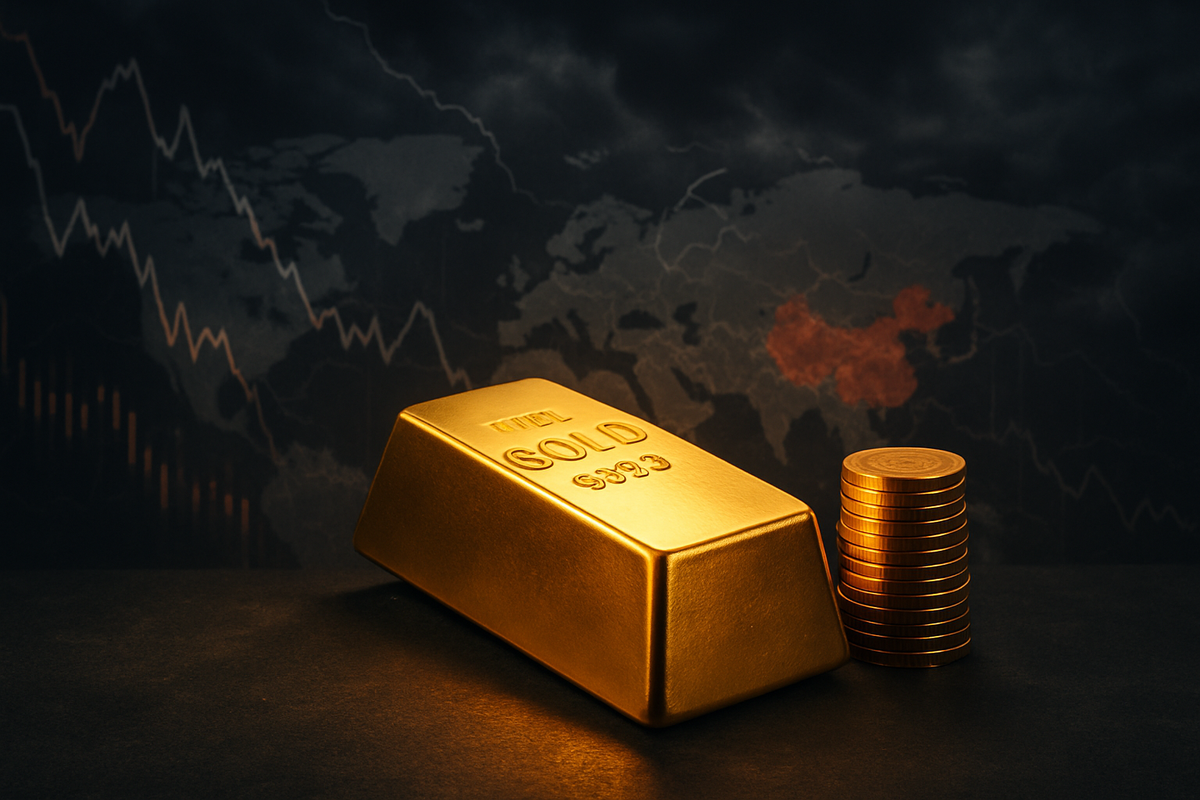
New York, NY – October 16, 2025 – Gold, the perennial safe-haven asset, has surged to unprecedented heights this week, shattering all previous records and breaching the $4,250 per ounce mark. This historic rally, with prices reaching an all-time high of approximately $4,250.73 in October 2025, and specifically $4,248.39 per troy ounce on October 16, 2025, underscores a profound shift in investor sentiment, signaling deepening market uncertainties and a desperate flight to safety amidst a confluence of global economic and geopolitical anxieties. The yellow metal's ascent reflects a growing lack of confidence in traditional financial instruments and a widespread search for stable stores of value.
The immediate implications of gold's meteoric rise are significant, painting a picture of an increasingly volatile global landscape. Investors are clearly seeking refuge from escalating US-China trade tensions, the specter of a weakening US dollar, and persistent inflation concerns. Furthermore, the anticipation of aggressive interest rate cuts by the Federal Reserve, coupled with broader geopolitical instability and the ever-present worries surrounding the burgeoning US national debt, are collectively fueling this unprecedented demand for gold. This surge is not merely a fleeting market anomaly but rather a powerful indicator of fundamental shifts in investor psychology and a palpable unease permeating the global financial system.
Gold's Unprecedented Ascent: A Detailed Look at the Drivers
Gold's journey to record highs has been a rapid and consistent one throughout October 2025, culminating in its historic breach of the $4,200 and then $4,250 thresholds. On October 14, 2025, the price of gold had already peaked at US$4,179.61, only to be surpassed in subsequent trading days. By October 15, gold had crossed $4,200, advancing further to $4,226.76 in early trading on October 16, ultimately reaching its current all-time high. This remarkable rally represents an astounding increase of over 57% year-to-date, reflecting a sustained and intensifying demand for the precious metal.
Several critical factors have converged to propel gold into uncharted territory. At the forefront are escalating US-China trade tensions, which have taken a turn for the worse with China expanding rare earth element export restrictions in retaliation to US calls for bans on equipment sales to Chinese chip-makers. The threat of additional US tariffs has amplified global uncertainty, pushing investors towards gold as a traditional hedge against economic fallout. Simultaneously, expectations of a dovish shift in US monetary policy, particularly the anticipation of Federal Reserve interest rate cuts, have made gold a more attractive investment. Remarks from Fed Chair Jerome Powell hinting at a weakening labor market have led markets to largely price in a 25-basis-point rate cut in October, with another likely in December. Lower interest rates reduce the opportunity cost of holding non-yielding assets like gold, thereby increasing its appeal.
The weakening US dollar, a direct consequence of the anticipated rate cuts, has further bolstered gold's attractiveness, making the dollar-denominated commodity more affordable for foreign buyers. Beyond these economic levers, a pervasive sense of geopolitical and economic instability is driving the flight to safety. Ongoing conflicts in Eastern Europe, instability in parts of Asia, and domestic political uncertainties in major economies, including a recent US government shutdown, have exacerbated market jitters. Gold, often dubbed a "crisis commodity," thrives in such turbulent times, offering a perceived sense of security. Persistent inflation concerns also play a significant role, as investors seek gold to protect their wealth against the erosion of purchasing power.
Adding to the complexity are concerns over the substantial US national debt, which surpassed $35 trillion in 2024 with a debt-to-GDP ratio around 123%. Such figures amplify worries about long-term economic stability, further solidifying gold's role as a reliable store of value. Importantly, strong central bank demand globally has also been a consistent driver, indicating a fundamental shift in investment patterns beyond traditional safe-haven demand. Central banks are increasingly diversifying their reserves, viewing gold as a crucial asset in an unpredictable global financial environment. This collective demand from both institutional and individual investors has created a powerful upward momentum, culminating in gold's current record-breaking valuation.
Corporate Fortunes Shift: Winners and Losers in Gold's Golden Age
The unprecedented surge in gold prices to record highs is creating a clear bifurcation in corporate fortunes, significantly impacting various public companies across different sectors. This environment, characterized by geopolitical tensions, economic uncertainties, persistent inflation fears, and a weakening U.S. dollar, enhances gold's appeal as a safe-haven asset, directly benefiting some while posing substantial challenges for others.
The most immediate and obvious beneficiaries are gold mining companies. Their profitability often sees a disproportionate increase due to operational leverage; as gold prices rise significantly, revenues grow faster than relatively stable production costs, leading to expanded profit margins and higher cash flows. Leading the pack are major players like Newmont Corporation (NYSE: NEM), the world's largest gold producer, which has seen its stock increase by an impressive 140% year-to-date in 2025. Barrick Gold (NYSE: GOLD) also reported a 44% increase in adjusted net profit in Q2 2025 and has increased its dividends, showcasing the direct positive impact. Other significant winners include Agnico Eagle Mines Limited (NYSE: AEM), known for efficient cost structures, and Kinross Gold (NYSE: KGC), which is advancing its projects with an expected earnings growth rate of 111.8% for the current year. Gold royalty and streaming companies like Franco-Nevada Corporation (NYSE: FNV) are also reaping immense benefits, enjoying exceptionally high operating margins as their revenue streams swell without direct mining costs.
Precious metals Exchange-Traded Funds (ETFs) are also experiencing unprecedented inflows, making them direct beneficiaries. Funds such as SPDR Gold Shares (NYSEARCA: GLD) and iShares Gold Trust (NYSEARCA: IAU) aim to mimic the price of gold and have seen substantial gains, with GLD gaining over 50% in the past year. The VanEck Gold Miners ETF (NYSEARCA: GDX), which tracks gold miners, has surged 121% year-to-date, reflecting the robust performance of the underlying mining companies. Indirectly, suppliers to the mining industry, such as heavy equipment manufacturers like Caterpillar (NYSE: CAT), Komatsu (OTCMKTS: KMTUY), and FLSmidth (CPH: FLS), could also see increased demand as miners, flush with cash, invest in expanding exploration and enhancing operations.
Conversely, industries heavily reliant on gold as a raw material or sensitive to economic instability are facing headwinds. The jewelry industry is significantly challenged, as higher gold costs directly translate to increased retail prices, often leading to reduced consumer demand. Companies like Signet Jewelers (NYSE: SIG) are grappling with increased input costs and potential shifts in consumer behavior towards lighter-weight designs or alternative materials. Even luxury jewelers, such as Tiffany & Co. (owned by LVMH (OTCMKTS: LVMUY)), may see shifts in purchasing habits. The electronics and semiconductor industry, where gold is a critical component for its conductivity and corrosion resistance, is also feeling the pinch. Manufacturers face increased production costs, impacting margins, as evidenced by Chipbond Technology reporting a 4% drop in gross margins in 2024 due to surging gold costs. Discretionary consumer goods manufacturers like Apple (NASDAQ: AAPL), which utilize gold in their electronics, could also face increased component costs. Beyond these direct impacts, companies sensitive to broader economic instability or inflation, such as retailers (Target (NYSE: TGT), Walmart (NYSE: WMT)), travel and leisure industries (Delta Air Lines (NYSE: DAL), Marriott International (NASDAQ: MAR)), and financial institutions (JPMorgan Chase (NYSE: JPM), Bank of America (NYSE: BAC)), could face reduced consumer spending, market volatility, and increased credit risks as the flight to gold signals a more challenging economic outlook.
A New Golden Era: Wider Significance and Market Repercussions
Gold's dramatic ascent to over $4,200 per ounce, culminating in its current record high of approximately $4,250.73 in October 2025, is far more than a mere price spike; it signifies a profound recalibration of global financial strategies and investor psychology. This almost 60% increase in 2025 alone, outperforming major asset classes like U.S. stocks and bonds, is deeply embedded within broader industry trends and carries significant ripple effects across the financial ecosystem.
The current rally is largely driven by a confluence of macroeconomic and geopolitical factors that have been building for some time. Expectations of Federal Reserve rate cuts later in 2025, aimed at stimulating a potentially weakening economy, have weakened the U.S. dollar and reduced real yields. This makes non-yielding assets like gold increasingly attractive, as the opportunity cost of holding gold diminishes. Geopolitical tensions, particularly the renewed U.S.-China trade friction, ongoing conflicts in Eastern Europe, and political instability across various regions, have collectively intensified the demand for gold as the quintessential safe-haven asset. Gold's role as a "crisis commodity" is once again being emphatically demonstrated, providing a refuge for capital in times of global stress.
Perhaps one of the most significant, yet often underreported, trends is the aggressive accumulation of gold by central banks worldwide. Institutions, especially in Asia and the Middle East, have been purchasing gold at record levels, exceeding 1,000 metric tons annually in both 2023 and 2024. This concerted effort is a strategic move to diversify reserves away from U.S. dollar-denominated assets, protect against potential sanctions, and build strategic reserves amid shifting global economic power dynamics and de-dollarization efforts. This institutional demand provides a robust floor for gold prices and signals a long-term shift in global monetary policy. Furthermore, persistent inflationary concerns, with U.S. inflation still around 3.4%, coupled with fears over the debasement of the U.S. dollar due to high U.S. debt and deficits, continue to fuel demand for gold as an inflation hedge. Some analysts even suggest that gold is being used as a hedge against a potential speculative "AI bubble" in the stock market, where high valuations are concentrated in a few mega-cap tech stocks.
The ripple effects extend beyond direct gold-related industries. For other safe-haven assets, gold's strong performance underscores its enduring appeal, often moving independently of (or inversely to) riskier assets, thus solidifying its role as a valuable portfolio diversifier. While cryptocurrencies like Bitcoin have shown similar safe-haven tendencies, gold's historical consistency remains largely unmatched. In the gold mining industry, record prices translate into significantly expanded profit margins, incentivizing increased exploration budgets and project development, and making previously uneconomical lower-grade deposits viable. This could lead to increased merger and acquisition activity within the sector, though technical challenges like declining ore grades and rising environmental regulations continue to limit new mine supply. The jewelry industry, however, faces direct challenges from soaring gold costs, leading to higher retail prices. Consumers are responding by selling old gold to capitalize on high prices and adapting purchasing habits, forcing jewelers to innovate with smaller pieces, lower-carat gold items, and a focus on investment-worthy or custom-made designs.
Regulatory and policy implications are also emerging. Central banks are actively adjusting their reserve management strategies, with surveys indicating that 95% expect global central bank gold reserves to increase over the next 12 months. This trend reflects a deliberate strategy to reduce reliance on the U.S. dollar and diversify assets. Governments are also closely watching import/export policies in major markets like India and China, as these influence global gold flows. The political pressure on monetary policy decisions globally is seen as undermining confidence in fiat currencies, further driving demand for alternative store-of-value assets like gold.
Historically, gold's current rally draws parallels to the 1970s, when prices surged due to pronounced U.S. government spending and reduced central bank credibility, leading to rampant inflation. Gold's performance in 2025 is on track to be its strongest calendar year performance since 1979. Significant spikes were also observed during the 2008 financial crisis, the 2010-2012 European debt crisis, and the COVID-19 pandemic in 2020. The current rally's swiftness, moving from $3,500/oz to over $4,000/oz in just 36 days, highlights the intensity of the present market anxieties. While the nominal price is a record, it was only in April 2025 that the inflation-adjusted price surpassed the 1980 peak. Experts are divided on whether this is a temporary spike or the start of a new, sustained long-term cycle, but the underlying drivers suggest a more fundamental shift in the global financial landscape.
The Road Ahead: Navigating Gold's Uncharted Territory
With gold having established fresh record highs above $4,200 per ounce in October 2025, the market now grapples with what comes next for the precious metal and the broader financial landscape. The outlook is complex, characterized by both strong bullish sentiment and the potential for short-term corrections, demanding strategic pivots from investors and institutions alike.
In the short term, specifically through Q4 2025 and early 2026, the market presents a mixed picture. While the underlying drivers of gold's rally remain robust, technical indicators, such as the 14-day Relative Strength Index (RSI), suggest that gold is currently "overbought." This condition often precedes a healthy correction, with some experts anticipating a pullback of 10-15% before the upward trend potentially resumes. Such profit-taking could be triggered by stronger-than-expected U.S. economic data, a rebound in the U.S. dollar, or a diplomatic easing of geopolitical tensions. However, despite these signals, many analysts predict that gold prices could continue their ascent, potentially reaching $4,400-$4,500 by the end of 2025, driven by persistent safe-haven demand, sustained central bank accumulation, and ongoing macroeconomic uncertainty.
Looking further ahead into 2026 and beyond, the long-term outlook for gold remains predominantly bullish. Major financial institutions and precious metals analysts largely concur, with forecasts clustering around the $4,000-$5,000 per ounce range for 2026. Goldman Sachs projects gold to reach $4,500 in 2025 and $4,900 in 2026, even positing a possibility of hitting $5,000 by mid-2026. Bank of America has similarly raised its 2026 gold price forecast to $5,000 per ounce, while JPMorgan Chase & Co. anticipates prices to average $3,675 per ounce by Q4 2025 and surpass $4,000 per ounce by Q2 2026. The continuation of aggressive central bank purchasing, the anticipated rate-cutting cycle by the U.S. Federal Reserve, persistent inflation concerns, and an enduring climate of geopolitical and economic uncertainty are expected to be the primary catalysts for this sustained appreciation. A weakening U.S. dollar and strong investment demand from ETFs and physical gold purchases will further bolster this trend, while limited supply growth from mining operations will help maintain price floors.
For investors, strategic adaptation is paramount. Gold's historically low correlation with traditional financial assets makes it an invaluable tool for enhancing risk-adjusted returns and providing portfolio insurance during systemic risks. Investors should embrace diversification, but also anticipate volatility, recognizing that pullbacks could present opportune buying moments for long-term positions. Implementing robust risk management strategies and clearly defining gold's role within an investment portfolio are crucial. Central banks are expected to continue their pivot away from U.S. dollar-denominated assets, further diversifying their reserves with gold, a trend that could even accelerate amid concerns about U.S. economic leadership and policy uncertainty. For mining companies, the anticipated high gold prices translate into increased revenues and potentially higher profit margins, likely spurring increased exploration and production efforts, though supply growth is generally expected to remain limited.
The market opportunities emerging from this golden era include the potential for innovative investment products to attract new demographics, and the sustained institutional demand from central banks and large investors providing a strong floor and upward momentum for prices. Gold's role as a portfolio stabilizer during financial market volatility and late-cycle economic environments will become increasingly pronounced. However, challenges persist. A significant strengthening of the U.S. dollar or a substantial increase in real interest rates could dampen gold's appeal. A de-escalation of major geopolitical conflicts could reduce safe-haven demand, leading investors back to "risk-on" assets. While less likely in the current environment, deflationary pressures would be unfavorable for gold, which thrives in inflationary periods. Furthermore, the rapid price increase has led to "overbought" conditions, indicating that short-term corrections are a strong possibility, and extremely high prices could deter opportunistic buyers and consumer demand for jewelry. Ultimately, while a bullish scenario for gold appears to have high probability, investors must remain vigilant to market signals and be prepared for various outcomes.
The Golden Horizon: A Comprehensive Wrap-Up and Forward Look
Gold's extraordinary journey to unprecedented highs in October 2025, breaching the $4,200 per ounce mark and establishing fresh all-time records, marks a historic year for the precious metal. This near 60% surge in 2025 alone, outperforming major asset classes, underscores a profound shift in global financial dynamics and investor sentiment. The key takeaways from this monumental rally are multifaceted, pointing to a persistent environment of uncertainty and a strategic re-evaluation of asset allocation.
At its core, gold's ascent is a testament to its enduring role as the ultimate safe-haven asset. Escalating geopolitical tensions across the Middle East and Europe, coupled with renewed US-China trade friction, have consistently driven investors towards gold as a reliable store of value. Simultaneously, expectations of continued monetary easing by the U.S. Federal Reserve, with multiple interest rate cuts anticipated in late 2025 and into 2026, have significantly boosted gold's appeal by reducing the opportunity cost of holding the non-yielding asset and weakening the U.S. dollar. This weakening dollar further enhances gold's attractiveness to international buyers. Crucially, aggressive accumulation by central banks globally, particularly in emerging markets, signifies a structural shift towards de-dollarization and diversification of reserves, providing a robust and sustained demand floor for gold prices. Persistent inflation concerns, despite central bank efforts, also continue to position gold as a vital hedge against the erosion of purchasing power, while equity market volatility, fueled by concerns over technology bubbles, pushes investors towards safer havens.
Moving forward, the market consensus among major financial institutions and analysts points to continued strength in the gold market through 2026, though with an acknowledgment of potential short-term corrections. Major banks like Goldman Sachs and Bank of America have revised their forecasts upwards, projecting gold could reach $4,900 to $5,000 per ounce by 2026. This bullish outlook is supported by the expectation of continued central bank buying, structural under-ownership of gold in many portfolios, and limited supply growth from mining operations. However, investors should be mindful that gold is currently "overbought" on technical charts, suggesting that a short-term pullback of 10-15% would be a "healthy" market correction after such a rapid ascent. A significant strengthening of the U.S. dollar, an unexpected increase in real interest rates, or a faster-than-expected moderation of inflation could trigger such a correction.
The lasting impact of gold's record highs extends beyond mere price action; it signifies a broader erosion of confidence in traditional financial systems, currency stability, and geopolitical order. The aggressive central bank buying, particularly by emerging markets, highlights a long-term strategy of de-dollarization and diversification of reserves, fundamentally altering global financial architecture. This "east-to-west power transition" in gold ownership is a profound development. The current bull run, compared to historical rallies, appears to be in its "early innings," implying that gold's structural tailwinds could provide support for an extended period, reaffirming its role as the "ultimate store of value" in an increasingly uncertain world.
For investors navigating these uncharted waters, vigilance is key. Monitor the Federal Reserve's policy decisions and the pace of interest rate cuts, as these will directly influence gold's attractiveness. Keep a close eye on U.S. dollar strength, as a weakening dollar generally boosts gold demand. Geopolitical developments, particularly in Ukraine, the Middle East, and U.S.-China trade relations, will continue to drive safe-haven demand. Inflation data and central bank buying trends, especially from emerging markets, will provide crucial insights into gold's underlying demand. Finally, watch for technical indicators that might signal short-term profit-taking or pullbacks, which could present strategic buying opportunities for long-term investors. The record-breaking rally of 2025 has cemented gold's status as a critical asset, and its trajectory in the coming months will be a defining narrative of the global financial landscape.
This content is intended for informational purposes only and is not financial advice





